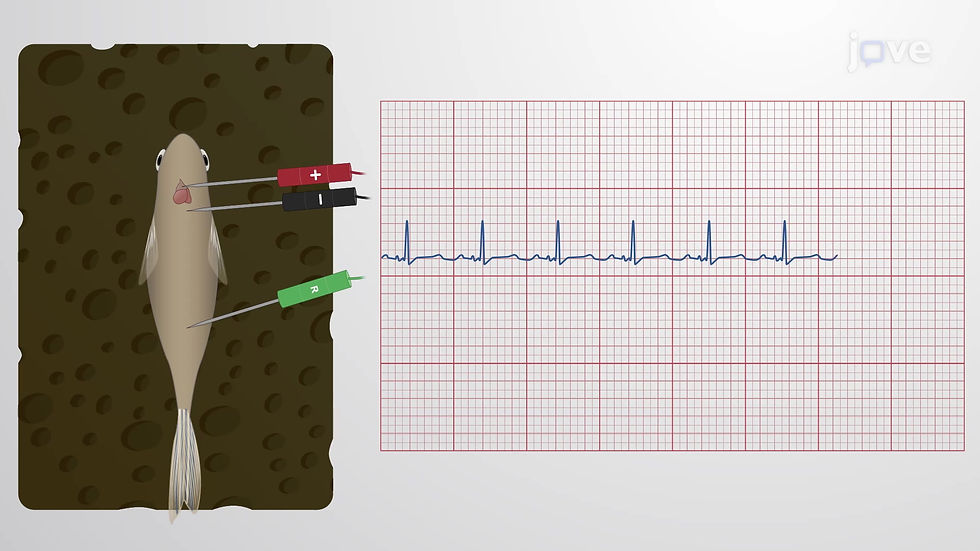Why understanding the origins of EKGs may help you catch that trout... 🎣🫀
- biteme988
- Jul 31, 2024
- 3 min read
Updated: Oct 28, 2024
Here's a hint: It all starts with the P wave 🧐.

“Do you know why they call it a p-wave?” said the surgeon next to me.
"Uhh.... No. I have no idea," I said.
And he went on, "seems weird they'd start in the middle of the alphabet and not the beginning, right?"
Doubt is the origin of wisdom. - Rene Descartes
Mother Trucker. I hate when surgeons ask me physiology questions I don't know the answer to. I mean, I'm a board-certified anesthesiologist. I should know everything there is to know about EKGs (electrocardiograms), right?

I look at them all day long. I hear their beeps in my dreams. But never once did it dawn on me to ask myself the question, why does the conventional naming of waves on a normal EKG go P, Q, R, S and T?
And now a surgeon (of all people!), who just pieced a shattered dog's pelvis back together, scrubs out of surgery and asks me this?!
It all starts with a "P" (an abbreviation of "le point") that Descartes wrote about 400 years ago.

But that's the cool thing about working with super smart people. They always challenge you.
Only the contest made me a poet, a sophist, an orator. - Plato
So off I went that night on googling why they call it a P wave. And the story is quite beautifully interconnected over 300 years of science and mathematics. It's also the foundational discovery of refraction - something we see every day on the water as anglers.
The Snell-Descartes Law: a formula used to describe the relationship between the angles of incidence and refraction, when referring to light or other waves passing through a boundary between two different isotropic media, such as water, glass, or air
(1).
It turns out that Descartes figured out refraction about 400 hundred years ago. And when he started creating his geometry explanations, he started with P for Point.
Fast forward 300 years and William Einthoven started experimenting with what now became the modern day EKG. He won the Nobel Prize for figuring out the geometry of it, but to do it, he had to read a fair amount of Descartes' work (4).
Einthoven used P as the starting letter for the first wave on the EKG, well, because that's what Descartes used. Einthoven also speculated that if he chose letters from the middle of the alphabet, then there would be letters available before and after it if new waves were discovered.
Which leads us to fishing, particularly the visualization of fish under water.
Fishing guides would argue you need polarized glasses to see trout underwater. But I'd argue you need polarized glasses, the Snell-Descartes Law, and a whole hell of a lot of patience if you're new to spotting fish in the stream. Like literally, it took a guide 10 minutes of him pointing until I saw the flash of the trout fin.

Snell's Window
I don't really think it's fair to talk about the Snell-Descartes Law without mentioning the concept of Snell's Window. If you've ever spent a lot of time at the bottom of the well of a deep pool, you know exactly what this is, and it actually has a name...
Snell's window is a phenomenon by which an underwater viewer sees everything above the surface through a cone of light of width of about 96 degrees. This phenomenon is caused by refraction of light entering water, and is governed by Snell's Law. The area outside Snell's window will either be completely dark or show a reflection of underwater objects by total internal reflection (5).

We're all a lot more similar than we think.
You may think you look really different from a fish. You may say that fish have a 2 chambered heart, and mammals have a 4 chambered heart. But when it comes to EKG tracings, and assessing electrical activity of the heart, well, we all have a P, Q, R, S and T. So please keep being kind to your fellow humans and your fellow fish! 🐟
Here are a couple interesting fish EKG papers if you'd like to read more.

Zebrafish Electrocardiography (ECG): A Minimally Invasive Assay to Evaluate Cardiac Function (https://app.jove.com/v/20079/zebrafish-electrocardiography-ecg-a-minimally-invasive-assay-to-evaluate-cardiac-function)

Stay wild and free!
Winston & Ashley
References
Snell's' Law: https://en.wikipedia.org/wiki/Snell%27s_law
Refraction of Light image: https://en.wikipedia.org/wiki/Snell%27s_law#/media/File:Snells_law2.svg
Refraction and Spearfishing: https://mammothmemory.net/physics/refraction/refraction-and-spearing-a-fish/refraction-and-spearing-a-fish.html
Naming of Waves of an EKG: https://www.ahajournals.org/doi/10.1161/01.CIR.98.18.1937
Snell's Window. https://en.wikipedia.org/wiki/Snell%27s_window
Zebrafish heart as a model for human cardiac electrophysiology
Article
Full-text available. https://www.researchgate.net/figure/Comparison-of-human-and-zebrafish-electrocardiograms-ECG-Top-ECG-of-an-adult_fig3_287147136




Comments